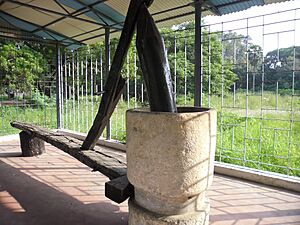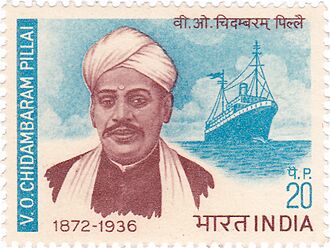V. O. Chidambaram Pillai facts for kids
Quick facts for kids
V. O. Chidambaram Pillai
|
|
|---|---|

Chidambaram in 1919
|
|
| Born |
Vallinayagam Olaganathan Chidambaram Pillai
5 September 1872 Ottapidaram, Tirunelveli district, Madras Presidency, British India
(present-day Thoothukudi district, Tamil Nadu, India) |
| Died | 18 November 1936 (aged 64) Thoothukudi, British India
|
| Nationality | Indian |
| Other names | Kappal Ottiya Tamilzhan, Chekkilutta Chemmal |
| Organization | Swadeshi Steam Navigation Company |
| Political party | Indian National Congress |
| Movement | Indian Independence Movement |
| Spouse(s) | Meenakshi |
| Children | 4 sons, 4 daughters |
Vallinayagam Olaganathan Chidambaram Pillai (born September 5, 1872 – died November 18, 1936) was an important Indian freedom fighter. He was also a lawyer, a businessman, and a politician. He started his own shipping company, the Swadeshi Steam Navigation Company, in 1906. This company aimed to compete with the powerful British shipping company that controlled all the sea routes.
He launched the first Indian-owned shipping service between Tuticorin (in India) and Colombo (in Sri Lanka). He was a member of the Indian National Congress political party. The British government later accused him of speaking against them and gave him a long prison sentence. His license to practice law was also taken away. He is famously known as Kappalottiya Tamizhan, which means "the Tamil helmsman" or "the Tamil who drove the ship". One of India's major ports, the Tuticorin Port Trust, is named after him.
Contents
Early Life and Education
V. O. Chidambaram Pillai was born in Ottapidaram, in the Tirunelveli District. His parents were Olaganathan Pillai and Paramayee Ammal. When he was six, he learned Tamil from his teacher Veeraperumal Annavi. He also heard many stories from his grandparents, including tales about Shiva and from the Ramayana. He also heard stories from the Mahabharatha.
As a child, he learned many skills like horse riding, silambattam (a type of martial art), archery, and sword fighting. He also played kabaddi, swam, used stilts, wrestled, and played chess.
He learned English in the evenings from a government officer named Krishnan Iyyengar. Later, his father built a school for him and hired a new English teacher. At fourteen, Chidambaram Pillai moved to Thoothukudi to continue his studies. He attended CEOA High School and Caldwell High School. He also studied at Hindu College High School in Tirunelveli.
Chidambaram Pillai worked briefly as a clerk in a government office. Then, his father sent him to Tiruchirappalli to study law. He passed his law exam in 1894 and started working as a lawyer in Ottapidaram in 1895.
In Madras (now Chennai), Chidambaram Pillai met Swami Ramakrishnananda, a saint from Swami Vivekananda's monastery. The saint advised him to serve his country. Here, he also met the famous Tamil poet Bharathiyaar. They shared similar ideas about politics and became close friends.
Joining the Freedom Movement
Becoming a Political Leader
In the late 1800s and early 1900s, India's fight for independence was growing stronger. The Swadeshi movement was also popular, encouraging Indians to use goods made in their own country. From 1892, Chidambaram Pillai was inspired by Bal Gangadhar Tilak, a famous leader, and became his follower.
Along with Subramanya Siva and Subramanya Bharathi, Chidambaram Pillai became a strong voice for freedom in the Madras region. After the division of Bengal in 1905, he joined the Indian National Congress political party. He took a firm stand against British rule. He also led a Congress meeting in the Salem District.
Starting New Companies
Chidambaram Pillai started many organizations, such as Yuvanesh Prachar Sabha and Dharmasanga Nesavu Salai. He also helped create the National Godown and the Madras Agro-Industrial Society.
He wanted to challenge the British India Steam Navigation Company (BISNC), which controlled all the shipping trade. So, Chidambaram Pillai started an Indian-owned shipping company. He officially registered the Swadeshi Steam Navigation Company in October 1906. The company raised a lot of money, and anyone from Asia could buy shares. Pandi Thurai Thevar was the director, and Haji Pakkir Mohammed Rowther Sait became the secretary.
At first, the company did not own any ships. They rented them from another company. But the British company pressured the rental company to cancel the agreement. In response, Chidambaram Pillai rented a large ship from Sri Lanka. He realized his company needed its own ships. So, he traveled across India, selling shares to raise money. He promised, "I will come back with ships. Otherwise, I will perish in the sea."
He successfully raised enough money to buy the company's first ship, the S.S. Gallia. Soon after, they bought another ship, the S.S. Lavo, from France. The British company tried to compete by lowering their ticket prices. Chidambaram's company also lowered its prices. The British company even offered free trips and umbrellas, but many people still chose the Indian company because of their nationalist feelings. The British company tried to buy out Chidambaram, but he refused. His ships began regular service between Tuticorin and Colombo, despite strong opposition from British traders and the British government.
The Coral Mill Strike
On February 23, 1908, Chidambaram Pillai gave a speech in Thoothukudi. He encouraged the workers at Coral Mill to protest their low wages and poor working conditions. Four days later, the workers went on strike, led by Subramanya Siva and Chidambaram himself. They demanded better pay, weekly holidays, and other benefits.
Chidambaram made sure the strike was widely known, and it quickly gained public support. On March 6, the mill management agreed to meet their demands. Chidambaram and 50 workers met the managers, who agreed to increase wages, reduce working hours, and give Sundays off. The workers returned to work after a nine-day strike. This success encouraged workers in other European companies to demand better conditions, and they also won increased wages.
Arrest and Imprisonment
By 1908, Chidambaram's political activities caught the attention of the British. A British official named Winch invited Chidambaram and his friend Subramanya Siva to meet him. Winch was worried about Chidambaram's actions and asked him to promise not to take part in any political protests. Chidambaram refused. So, he and Siva were arrested on March 12, 1908.
Their arrest led to widespread protests. In Thirunelveli, shops, schools, and colleges closed. Riots broke out, and government buildings were attacked. A general strike was called in Thoothukudi, which was the first political strike in India. Public meetings and marches were held, and four people were killed by the police.
Even though his supporters raised money for his bail, Chidambaram refused to leave jail without Siva and his other friends. Subramanya Bharathi and Subramanya Siva also appeared in court for questioning. Chidambaram was accused of speaking against the British and helping Siva. He was given a very harsh sentence of two life imprisonments, which meant 40 years in jail. He was held in the Central Prison, Coimbatore from July 9, 1908, to December 1, 1910.
Many people, even a British magazine, said the sentence was unfair. Chidambaram appealed his sentence, and it was reduced to four years in prison and six years in exile. Another appeal further reduced his sentence.
Chidambaram was held in Coimbatore and Kannanoor jails. He was not treated as a political prisoner. Instead, he was forced to do hard labor, which harmed his health. A historian later wrote that Chidambaram was "yoked (in place of bulls) to the oil press like an animal and made to work it in the cruel hot sun." He kept writing letters and legal requests from prison. He was finally released on December 12, 1912. Sadly, his Swadeshi Steam Navigation Company had already been shut down in 1911. The ships were sold to their competitors.
Later Life and Legacy
After his release, Chidambaram was not allowed to return to his home district. His law license had been taken away. He moved to Chennai with his wife and two young sons. There, he ran a small shop selling groceries and kerosene.
Chidambaram had a long correspondence with Mahatma Gandhi from 1915 to 1920. They met in 1915 when Gandhi visited Chennai. Some people of Indian origin in South Africa had collected money to help Chidambaram and sent it through Gandhi. Chidambaram did not receive the money for a while, leading to some letters between them. Once, Gandhi wrote a postcard to Chidambaram in Tamil with his own hand, which delighted Chidambaram.
In 1920, Chidambaram left the Indian National Congress because he disagreed with some of Mahatma Gandhi's ideas. He then focused on creating labor unions in Madras and on writing. After moving to Coimbatore, he worked as a bank manager.
He was not happy with his income, so he asked the court for permission to practice law again. A judge named E.H. Wallace allowed him to get his law license back. To show his thanks, Chidambaram named his last son Valacewaran. Chidambaram moved to Kovilpatti and worked as a lawyer.
He rejoined the Congress Party in 1927 and led a political meeting in Salem. He said he rejoined because he saw positive changes in the party's policies. However, after this meeting, Chidambaram again left the Congress. In 1929, he moved to Thoothukudi, where he spent his time writing and publishing Tamil books. He wrote a commentary on the first book of the Tirukkural, a famous Tamil text. Chidambaram Pillai spent his final years in poverty. He passed away on November 18, 1936, at the Indian National Congress office in Tuticorin.
Literary Works
Chidambaram Pillai was also a writer. Some of his works include:
- Meyyaram (1914)
- Meyyarivu (1915)
- Anthology (1915)
- Autobiography (1946)
- Many articles in various magazines
- Translation works
- Literary notes (commentary) on the Tirukkural
- Thirukural with literary notes of Manakudavar (1917)
- Tolkappiam with literary notes of Ilampooranar (1928)
Honours and Recognition
After his death, Chidambaram became known by special titles like Kappalottiya Thamizhan ("the Tamil who drove the ship") and "Chekkiluththa Chemmal" ("a great man who pulled the oil press in jail for his people").
The Indian Posts & Telegraphs department released a special postage stamp on September 5, 1972, to celebrate 100 years since his birth.
Many statues of Chidambaram have been built to honor him:
- At the entrance of the Congress committee office in Royapettah, Chennai (1939).
- At the arch of Palayamkottai, Tirunelveli.
- At Marina beach, Chennai (unveiled at the World Tamil Conference).
- At the port, Thoothukudi (unveiled by Indira Gandhi, a former Prime Minister).
- At Simmakkal, Madurai (unveiled by M. G. Ramachandran, a former chief minister of Tamil Nadu).
- At the commemorative building of V.O.C., Tirunelveli (unveiled by J. Jayalalithaa, a former chief minister of Tamil Nadu).
The Tuticorin Port was renamed V.O. Chidambaranar Port Trust. In 2022, it was again renamed as V.O. Chidambaranar Port Authority by the Government of India.
M.P. Sivagnanam, also known as Ma. Po. Si., wrote a biography of Chidambaram called Kappalottiya Tamizhan. This book helped make Chidambaram famous. R.A. Padmanabhan also wrote an important biography of V.O. Chidambaram Pillai in English in 1977.
In 1961, a film about Chidambaram's life, titled Kappalottiya Thamizhan, was made. Sivaji Ganesan played Chidambaram. The story of this movie was based on Ma. Po. Si.'s biography.



